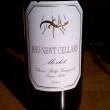What We Drank (December 14, 2009)
By Lenn Thompson, Editor-in-Chief
We only have two contributions to What We Drank this week, but they teach us two important lessons: don't ignore wines from poor vintages and don't give up on a wine too quickly if its corked.
From Lenn Thompson: Roanoke Vineyards 2003 Blend 2
I have a confession to make — as much wine as I drink, I tend to be a hoarder of special bottles. My cellar is filled with "last bottles" of many wines that I've enjoyed and purchased over the years. It's terrible, especially considering many of them aren't going to get much better than they are today and are only going to go downhill.
But, on Friday night, Nena requested "Something GOOD, maybe from Paumanok or Roanoke." And, being the loving (and smart) husband that I am I obliged, reaching into the Roanoke Vineyards corner of my cellar. I had two of these bottles and I could have very easily ended the weekend without any.
This blend of cabernet franc, cabernet sauvignon and merlot was one of the best local wines we've had in a while. And it's no where near done developing in-bottle either.
The black plum, blackberry and black cherry fruit core is still there, still bright and deep, is accented beautifully by layers of coffee bean, dark chocolate, exotic spices and an intriguing herb-marinated olive note. The tannins are round and mouth-filling, but smooth and supple.
I was curious to see how this wine would taste the day after opening. But the bottle didn't even make it until the end of that first night, serving as a strong reminder that you can't write off "lesser" vintages in any region. Look to the best growers and winemakers and you can find great wines even in challenging years like 2003 on the North Fork.
From Evan Dawson: Produttori del Barbaresco 2005 BarbarescoWhat
an interesting lesson in corked wine. It was immediately obvious that
this wine was corked, but it was not immediately obvious how badly the
cork taint had affected it. I poured a glass and let it rest for about
10 minutes before smelling the wine. The initial burst, before
swirling, was musty cardboard. But with some swirling this Nebbiolo
gave away many of its most classic characteristics: roses, tar,
strawberries and cream, along with a tangy metal streak.
That
first night, we followed the same routine: let the glass rest, notice
the cork taint building up, swirl to get past it. I thought of the TCA
in visual terms like a pudding that develops a hard skin that can
easily be broken through.On the second night the
musty cardboard was gone. A vibrant Nebbiolo nose remained. We've been
fortunate to avoid corked bottles for a while, and perhaps more
fortunate that this wine was only partially impacted.Hey, Mr. Mansell,
how commonly do you find partially corked bottles?














I’m interested in trying some Long Island wines and thank you for the post about the Roanoke.
TCA is a funny thing. It’s one of the more potent aroma chemicals out there (detected around parts per trillion) but we also get used to it very quickly.
It’s more likely that your nose got accustomed to (suppressed) the aroma of TCA as you swirled. Unlike hydrogen sulfide, which is very volatile, TCA is difficult to have “blow off”.
My solution: smell the heck out of the wine after opening, then enjoy. You may get some more TCA on the palate (warming it up will release more). Or you could try my Saran wrap trick…
Anecdote: In my wine faults practical in Gavin’s class, TCA was one of the spikes and it was probably spiked up around 1 ppb (unmistakeable). The whole basement of Stocking Hall smelled like cork taint, but after spending a while in the practice area I had a hard time telling between the spiked and unspiked TCA wines. Pretty much everyone’s nose had adjusted to the TCA in the air. Luckily, when I took the test, it was in a different room and I had some time to readjust.
Trying to enjoy a wine’s natural bouquet through faint cork taint is like trying to listen to a symphony with a neighbor’s cell phone ringing incessantly.
Kareem -
Brevity is the soul of wit. Why do we not get to enjoy more of your comments on this blog? Keep it coming!
Kareem makes a great point. Even if it’s not detectable as cork taint, a little bit of TCA can suppress fruit… which is why many winemakers are starting to avoid cork altogether.